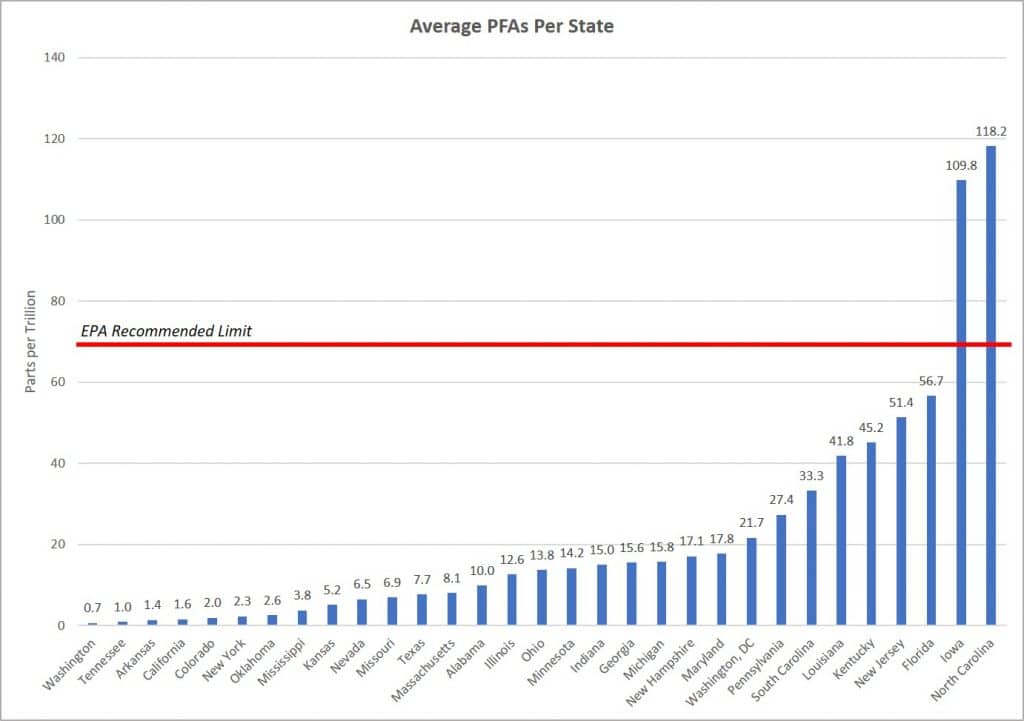What Are PFAS Contaminants?
PFAS contaminants are a group of manufactured chemicals, known as “forever chemicals,” that are a part of the perfluoroalkyl family. The most common PFAS that people are exposed to are Perfluorooctanoic Acid (PFOA) and Perfluorooctane Sulfonate (PFOS), which can have negative effects on your health.
These chemicals gained increasing popularity after their introduction to consumer products in the 1940s. They have many benefits that have improved household products over the years. These include properties such as the ability to repel a variety of substances, like water, stains, oils, and fire. PFAS are used in non-stick cookware, water repellent fabrics, stain guards, polishes, paints, and electrical insulation. PFAS can also be found in medical products such as surgical gowns and drapes because of their ability to repel bacteria and prevent infection.

Health Effects of PFAS
Studies have shown that over the years, PFAS have leached into our environment, but the research is still being conducted to determine how they affect humans. The individual PFAS compounds must be tested to determine their health effects. However, initial studies show that at high doses, there are health issues that are related to long term exposure to certain PFAS compounds.
Because of their resistant properties, PFAS can build up in the human body. Over a lifetime, scientists believe that this can cause liver disease and kidney and testicular cancer as well as immunity deficiencies. PFAS can also cause developmental defects in growing fetuses if the mothers are exposed to high levels. As a result, the EPA has issued a health advisory for PFAS recommending that the level of PFAS in water be kept under 70 parts per trillion (ppt).
Because of these health concerns, certain PFAS chemicals are no longer used in the United States. Thanks to the PFOA Stewardship Program, a number of chemical manufacturers have agreed to no longer use PFAS in their products and factories.
How Do PFAS Get Into Water?
The most common way for PFAS to enter the water is through industrial waste. For example, bodies of water located near manufacturing plants that use PFAS are at high risk for contamination. There have also been recent news reports about water sources that experienced contamination due to their proximity to oil refineries and airfields where fire-fighting foams are heavily used.
Even bottled water is not safe from PFAS. PFAS do not easily break down, and once they enter the water, they can linger for an extended period of time. Bottled water that comes from a source contaminated with PFAS is likely to contain PFAS depending on the extent of purification the water undergoes. The International Bottled Water Association (a bottled water trade association) has now established limits much lower than the EPAs. Its member companies must not exceed 5 ppt for one PFA and no more than 10 ppt for more than one PFA.

Best and Worst States
The environmental working group tested 44 sites in 31 states to determine what states ranked best and worst for PFA limits. Washington state was the state with the lowest levels of PFAS, 0.7 ppt. At 118.2 ppt, North Carolina had the highest contamination levels. One of the trends that was highlighted in the test results was that the highest concentrations of PFAS were most often found in major metropolitan areas, such as Miami, Philadelphia, and New Orleans.

Testing Water for PFAS Contaminants
The EPA has developed and supports three tests for testing water levels of PFAS contaminants. The tests are referred to as Method 533, Method 537, and Method 537.1. These tests can identify 29 different PFAS. There are other tests available, but they may not have been specifically designed to test drinking water like the EPA tests. If you would like to test the drinking water in your home, office, or school, the EPA recommends contacting your state to find out if there is a state certified laboratory that can test for PFAS.
If you do find out that your drinking water contains high levels of PFAS chemicals, it is possible to remove this contaminant with a variety of traditional water purification methods. Activated carbon made from wood, lignite, and coal can be used to absorb the chemicals. Another alternative is an ion exchange treatment that uses charged ion exchange resins that act as magnets to attract and hold the PFAS contaminants. There are also high-pressure membranes such as those in reverse osmosis systems that are particularly effective for removing PFAS.
Water Quality Counts
If you are concerned about contaminants in your water, TestAssured offers a variety of testing kits that can help ensure the water you are drinking is safe. Poor quality water can contain anything from bacteria to pesticides and high chlorine levels that can impact your health. Testing your water is easy and convenient with a home or a laboratory testing kit.

